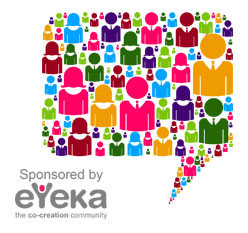
I’m happy to present the first visualization of the use of crowdsourcingby brands over time. This interactive timeline, called Crowdsourcing by World’s Best Global Brands, is built on Tiki-Toki, a tool to create timelines. Tiki-Toki turned out to be a good way to show how the use of crowdsourcing has exploded since the early 2000’s. The objective was indeed to have a rich and visual representation of how brands increasingly use of crowdsourcing to pursue marketing- and innovation-related business objectives. And the best part is: it will be crowdsourced.
Why a timeline?
Timelines are great way to visualize the occurence of past events, but also the evolution of a phenomenon. In recent years, crowdsourcing has proven to be a valuable way to access external knowledge, and a timeline was a simple yet effective way to show just that. Industry observer Ross Dawson has pioneered the idea with his timeline of acceleration of crowdsourcing, which even goes back to earlier centuries and government-funded innovation competitions. My version takes a narrower, academic definition of crowdsourcing, and is therefore focused on more recent crowdsourcing initiatives.
Here’s a screenshot of the timeline at the moment of the release:
This timeline shows how the world’s most valuable brands (the 100 brands included in Interbrand’s Best Global Brands ranking) use crowdsourcing. Rather than being a one-time illustration of how brands increasingly use crowdsourcing, I would like it to become a participative reference page to gather and display information about brand-sponsored crowdsourcing initiatives. In order to make it as complete as possible, you’re eagerly invited to contribute by submitting crowdsourcing initiatives that I might have missed.
–
What is the scope of this timeline?
But before, just let me explain the scope of the timeline as it is today:
- Definition of crowdsourcing: Crowdsourcing is defined as the process of posting a problem online, having a vast number of individuals offering solutions to the problem, awarding the winning ideas with some form of a bounty, and using this input for innovation, marketing or communication (Brabham, 2008).
- Type of crowdsourcing initiatives: Among the various forms of crowdsourcing that exist (Brabham, 2010; Schenk & Guittard, 2011; Pénin & Burger Helmchen; Geiger et al., 2011; Lampel et al., 2012), let’s limit the scope of this timeline to creative crowdsourcing i.e. web-based, distributed problem-solving were people are asked to contribute with creative output. This would leave aside micro-tasks or data-sourcing, focusing on crowdsourcing were peoples’ creative problem-solving skills are sollicited. The most common forms of such initiatives are innovation tournaments, idea contests, creative competitions or branded web-platforms for idea generation.
- Involvement of brands: We have limited the events of this timeline to crowdsourcing initiated and leveraged by brands for their innovation and/or marketing efforts. Sponsored initiatives (such as the Sony World Photography Awards) will be left out since the output is not directly used by the company.
- Brands in the scope of this timeline: As I already said above, the world’s most valuable brands are the 100 brands included in Interbrand’s Best Global Brands ranking. Our basis is the 2011 edition of the ranking, and the timeline will be updated with new entrants of the subsequent rankings.
I’m aware that these “rules” probably exclude some interesting crowdsourcing initiatives, but the objective is really to represent how, and how much, brands use crowdsourcing in their innovation and/or marketing processes. Don’t hesitate to comment on this post if you have suggestions for improvements and/or if you don’t agree with the above. I’d be glad to see a discussion emerge – even if…
discussion is only effective if you can stop people talking Clement Attlee
–
Participate to build this knowledge base!
There are probably crowdsourcing initiatives that have been missed as this timeline is being launched. To make it as comprehensive as possible, you are invited to contribute to this interactive document by submitting crowdsourcing cases that you know of. To do that, and to be listed as a contributor of the timeline (I can add a link to your website if you want), you just have to send an email to brandcrowdsourcingtimeline@gmail.com. Please make sure that…
- The initiative you submit falls into the scope of the timeline (see above)
- You provide a title, background information, results and outcomes
- You provide some visuals and/or videos to illustrate it
- You describe the initiative citing external sources
–
Last but not least…
Hopefully, your valuable help will allow us to build a rich, visual knowledge base! But the more information there will be on the timeline, the harder it will be to navigate. To help you to browse the timeline, there are some fantastic functionnalities hidden at the bottom right hand corner of the timeline:
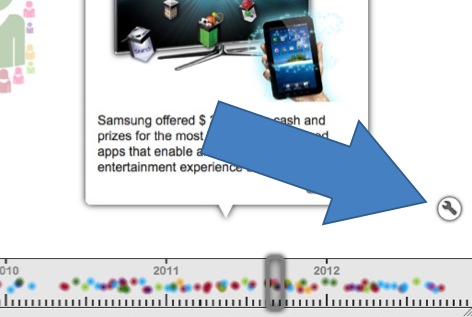
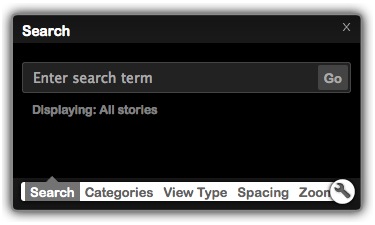 Search for text: If you’re looking for all the crowdsourcing initiatives by a particular brand, on a specific crowdsourcing platform, in a country… all you have to do is use the search function. You’ll be surprised!
Search for text: If you’re looking for all the crowdsourcing initiatives by a particular brand, on a specific crowdsourcing platform, in a country… all you have to do is use the search function. You’ll be surprised!
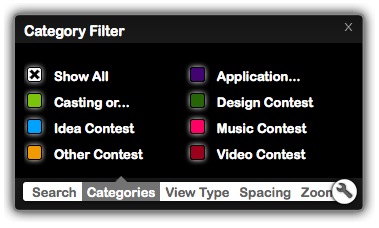 Refine categories: Only interested in video contests? Or would you like to leave out idea contests from the timeline? No problem, you can select/unselect categories as you want
Refine categories: Only interested in video contests? Or would you like to leave out idea contests from the timeline? No problem, you can select/unselect categories as you want
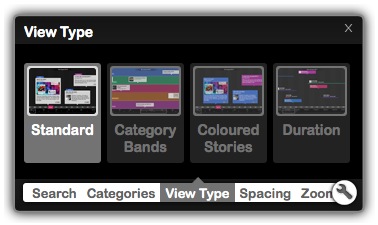
- Personalize visualization: Would you like to have events displayed differently? Or are you interested in visualizing the duration of the crowdsourcing initiatives? You’ll find various options to adapt visualization to your needs. At least I hope so!
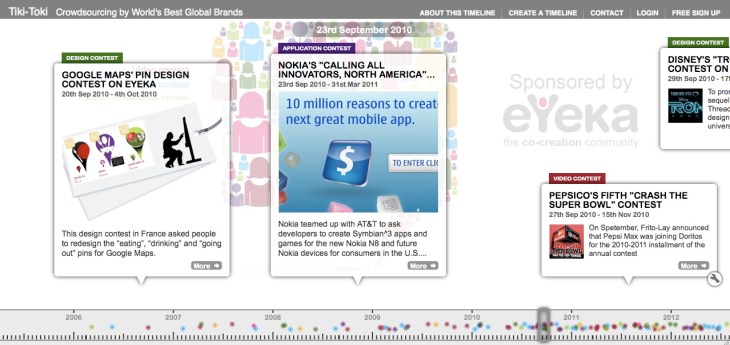
Yannig,
This is very cool. Can we repost with credit and links as we’ve done in the past?
Eric Mack Contributing Editor Crowdsourcing.org
Sure, go ahead Eric
this is really interesting indeed. I understand the scope you’ve chosen to narrow down the variety of examples. However, I think the definition you have picked (brabham, 2008) is not inclusive enough. It limits crowdsourcing to rewarded initiatives, a mechanism that is accessible on a large scale only to profit-driven companies, and therefore it excludes examples such as Mozilla, that would be relevant in your timeline, I think.
I can only suggest that you use Jeff Howe’s definition for the magazine Wired in 2006, which is more comprehensive.
Crowdsourcing is the act of taking a job traditionally performed by a designated agent (usually an employee) and outsourcing it to an undefined, generally large group of people in the form of an open call.
Anyway thanks for this timeline, it will be very useful for me.
JJ
Thank you for your comment, JJ. I get your point, and I’m happy to discuss the definition, but I think Brabham’s definition is much more recent and focused than Howe’s definition, who has not continued research on crowdsourcing since the release of his 2008 nook (correct me if I’m wrong). That’s why I use this rather precide and almost restrictive definition, and I think Mozilla-like projects are not crowdsourcing, they belong to the open-source paradigm, which is different. Some creative crowdsourcing applications are open-source, though (see http://pipeline.cc.gatech.edu/ for example) but the two concepts are different!
interesting view. Howe didn’t write anything new on the subject since 2008, but the most recent academic articles still refers to his definition.
The reason is that in my opinion crowdsourcing is very broad and is sometimes overlapping with the open source paradigm. They are different concepts when the company just give away the source code but doesn’t rely on the crowd to develop it. For example Android. But in the case of Mozilla, not only 50% of the code is developped by the crowd, but also most of the innovative ideas are crowdsourced. Not in the form of occasional contests but rather an ongoing conversation between the staff and the crowd.
However, given the broadness of the concept, I completely understand your choice to narrow it down to crowdsourcing contests.
Maybe this article would give you some interesting examples and references: (if you don’t know about it already)
Adamczyk, S., Bullinger, A. C., & Möslein, K. M. (2012). Innovation Contests: A Review, Classification and Outlook. Creativity and Innovation Management, 21(4), 335-360.
I myself work on a research project about crowdsourcing and how to attract and retain contributors. I would be very happy to have a further discussion with you on this topic.
JJ
Thank you, I know this article and it indeed provides a very valuable contribution. Drop me an email on the About Me section 🙂
Actually when I think about it, JJ, Adamczyk et al. don’t use the term “crowdsourcing” in their article. They talk about “innovation contests” and define them as IT-based and
time-limited competitions arranged by an organization or individual calling on the general public or a specific target group to make use of their expertise, skills or creativity in order to submit a solution for a particular task previously defined by the organizer who
strives for an innovative solution.”
This is exactly how I define crowdsourcing for the timeline. But I do agree that terms are often overlapping!